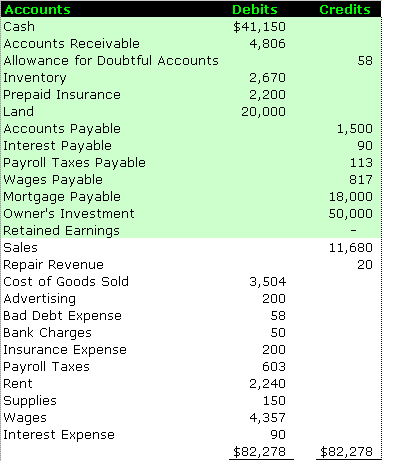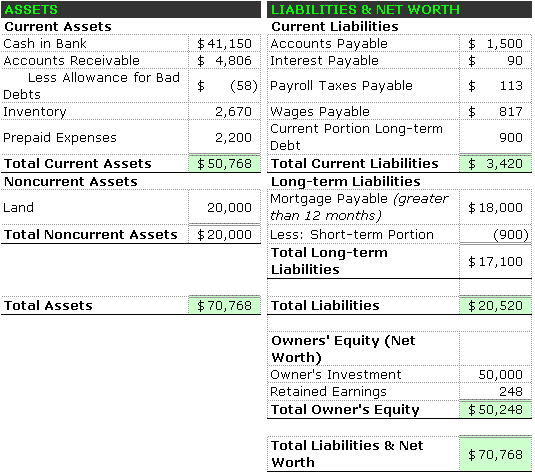Preparing the Balance Sheet in the Accounting Cycle
| Create the balance sheet template by using the asset, liability, and owner’s equity accounts on the adjusted trial balance to prepare the accounts in a balance sheet format. |
Sunny Sunglasses Shop
Adjusted Trial Balance Sheet
January 31, 2010
The balance sheet accounts, or real or permanent accounts, are highlighted on the adjusted trial balance above.
The adjusted trial balance shows the summary of assets, liabilities, and owner’s equity that we will now use to prepare the balance sheet template. Let’s see what happens when we plug these numbers into the accounting equation:
The balance of owner’s equity on the adjusted trial balance equals $50,000. The balance of owner’s equity in the accounting equation equals $50,248.
Where did the extra $248 come from?
The January income statement example in the prior section showed us that Sunny Sunglasses Shop earned $248 for the period. Closing entries made in the accounting cycle transfer the net profits or losses to the owners equity account each period. Because net income directly affects owner’s equity, the profit for the period increases equity as illustrated below.
Sunny Sunglasses Shop
Company Balance Sheet
January 31, 2010
Sunny used the net income for January to increase the retained earnings account. Because the balance in retained earnings was previously zero, retained earnings now equals the net income for the first month of business. After one year of operations, Sunny will increase retained earnings by the amount of net income for the year.
Like all permanent accounts, the retained earnings account accumulates the balance permanently. For example, if Sunny Sunglasses Shop earns net income of $15,000 in year one, and $20,000 after year two, the balance in retained earnings will equal the total accumulated earnings of $35,000. If a loss occurs for the accounting period, Sunny reduces retained earnings by the amount of the loss.
The business has completed the production of the monthly balance sheet in the accounting cycle.
Balance Sheet Template Summary
Business Financial Statements are produced from the account balances in the adjusted trial balance.
|




Bob –
Both GAAP and IFRS prefer a classified balance sheet format similar to the above, which is a horizontal format. Vertical formats are useful for using each line as a percentage of the total (e.g. current assets as a % of total assets), and comparing the ratios with other companies or prior periods.
Kenneth
which is the modern format, the horizontal or vertical one. your template is useful in that one can easily understand it.
Hi John –
An investor could always invest into the company by paying off a loan, thereby increasing net assets and his ownership interest (contributed capital – equity). Cash from operations can also pay off debt, but this is the result of earnings so you are not reducing retained earnings directly. Retained earnings can be distributed to shareholders via a cash dividend, thus reducing both assets and equity, but yes that would also mean net assets represent the retained earnings, and only transactions that reduce liabilities increase the ratio. Basically the closer the ratio is to one the more assets are owned instead of financed.
Revenues do not necessarily throw off the balance sheet, but is more or less just held temporarily in the income statement since the balance sheet does not represent that period until the income statement is closed. But to see how balance sheet accounts are currently affected, you can think of revenues as increasing equity and expenses as decreasing equity since these are essentially what closing entries do.
Kenneth
Thank you Kenneth!
In that case would you say the last paragraph below is a true statement about deleveraging?
Deleveraging is selling assets & using the proceeds (cash) to retire debt. Spending cash to retire debt will shrink the balance sheet.
Capital Ratio = Equity Capital/ Total Assets
You can’t deleverage through retained earnings. Retained earnings have no effect on the capital ratio since that increased equity (numerator) was offset by increased assets (denominator) earlier. Revenues increase assets (cash or accounts receivable) which throws the balance sheet out of balance. Retained earnings (moving net income from the income statement to the balance sheet) only bring the balance sheet back in balance.